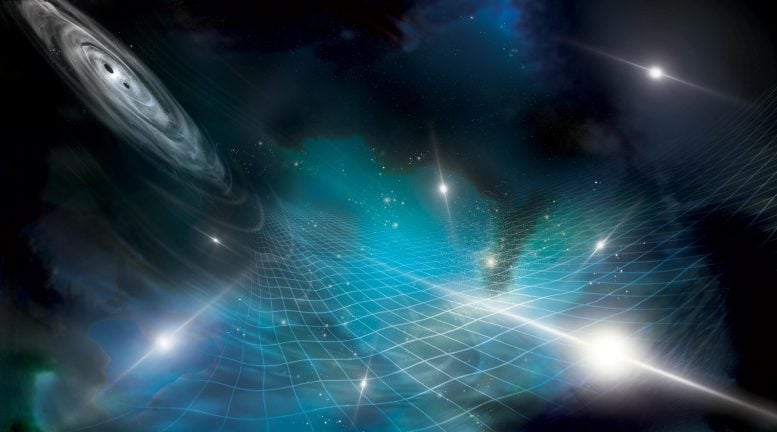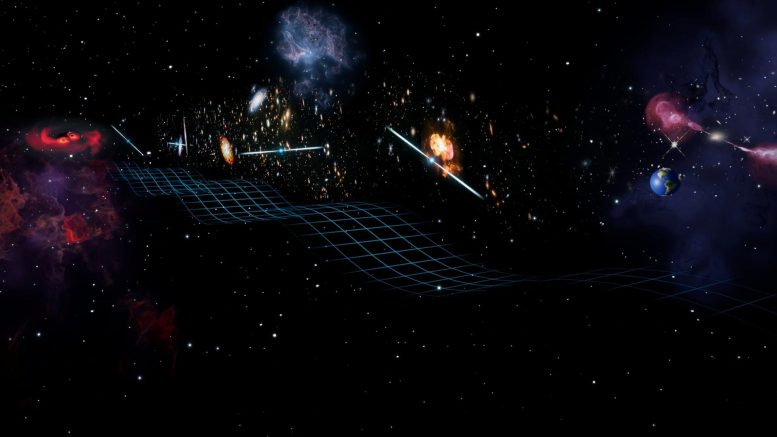
Radio telescope observations of Milky Way pulsars reveal spacetime distortions likely caused by enormous gravitational waves rolling through everything in existence
You can’t see or feel it, but everything around you — including your own body — is slowly shrinking and expanding. It’s the weird, spacetime-warping effect of gravitational waves passing through our galaxy, according to a new study by a team of researchers with the U.S. National Science Foundation’s NANOGrav Physics Frontiers Center.
The findings, which were recently published in The Astrophysical Journal Letters, are from the North American Nanohertz Observatory for Gravitational Waves (NANOGrav), a collaborative team of researchers from more than 50 institutions in the U.S. and abroad. The team conducted an analysis of burned-out stars known as millisecond pulsars, which rotate hundreds of times per second and emit radio pulses like ticks from highly accurate cosmic clocks. The team discovered what appeared to be variations in the “ticking rate” of such pulsars by comparing observations of more than 60 pulsars within radio telescope data spanning 15 years. Their analysis provides evidence that the variations are caused by low-frequency gravitational waves which are distorting the fabric of physical reality known as spacetime.

According to the NANOGrav team’s findings, the spatial distortion from the gravitational waves creates the appearance that the pulsars’ radio-signal ticking rates are changing. But really, it’s the stretching and squeezing of space between Earth and the pulsars which causes their radio pulses to arrive at Earth billionths of seconds earlier or later than expected. The results are the first evidence of the gravitational wave background — a sort of soup of spacetime distortions pervading the entire universe and long predicted to exist by scientists.
“The NSF NANOGrav team created, in essence, a galaxy-wide detector revealing the gravitational waves that permeate our universe,” said NSF Director Sethuraman Panchanathan. “The collaboration involving research institutions across the U.S. shows that world-class scientific innovation can, should and does reach every part of our nation.”
Gravitational waves were first predicted by Albert Einstein in 1916. They would not be confirmed until 2015, when the Laser Interferometer Gravitational-Wave Observatory (LIGO) detected spacetime ripples passing through the Earth. Although the source of those gravitational ripples was a collision of two far-off black holes, the resulting spatial distortion that LIGO detected was smaller than the nucleus of an atom.
By comparison, the apparent pulsar time shift measured by the NANOGrav team is a few hundred billionths of a second and represents a flexing of spacetime between Earth and the pulsars about the length of a football field. Those spacetime distortions were caused by gravitational waves so immense that the distance between two crests is 2-10 light-years, or about 9-90 trillion kilometers.
“These are by far the most powerful gravitational waves known to exist,” said West Virginia University astrophysicist Maura McLaughlin, co-director of the NANOgrav Physics Frontiers Center. “Detecting such gargantuan gravitational waves requires a similarly massive detector, and patience.”
Using 15 years of astronomical data recorded by radio telescopes at NSF-supported observatories — including Green Bank Observatory in West Virginia, the Very Large Array in Socorro, New Mexico, and Arecibo Observatory in Puerto Rico— the NANOGrav team created a “detector” of 67 pulsars distributed all across the sky and compared the ticking rate of pairs of those pulsars. Through a sophisticated data analysis, they deduced the presence of the gravitational wave background causing the distortion of space, and thus explained the apparent timing changes of the pulsars.
This is the first evidence for gravitational waves at these low frequencies,” said Vanderbilt University astrophysicist Stephen Taylor, chair of the NANOGrav collaboration and co-leader of the research effort. “The likely source of these waves are distant pairs of close-orbiting, ultra-massive black holes.”
“There is so much we have yet to understand about the physical nature of the universe and that’s why the National Science Foundation supports daring team efforts like NANOGrav — to expand our knowledge for the benefit of society,” said NSF Assistant Director for Mathematical and Physical Sciences Sean L. Jones.
The team’s results are providing new insights into how galaxies evolve and how supermassive black holes grow and merge. The widespread spacetime distortion revealed in their findings implies that extremely massive pairs of black holes may be similarly widespread across the universe, numbering perhaps in the hundreds of thousands or even millions. Eventually, the NANOGrav team expects to be able to identify specific supermassive black hole pairs by tracing the gravitational waves they emit. They may even uncover traces of gravitational waves from the very early universe.
“While our early data told us that we were hearing something, we now know that it’s the music of the gravitational universe,” said NANOGrav co-director and Oregon State University astrophysicist Xavier Siemens. “As we keep listening, individual instruments will come to the fore in this cosmic orchestra.”
For more on this research:
Reference: “The NANOGrav 15 yr Data Set: Evidence for a Gravitational-wave Background” by Gabriella Agazie, Akash Anumarlapudi, Anne M. Archibald, Zaven Arzoumanian, Paul T. Baker, Bence Bécsy, Laura Blecha, Adam Brazier, Paul R. Brook, Sarah Burke-Spolaor, Rand Burnette, Robin Case, Maria Charisi, Shami Chatterjee, Katerina Chatziioannou, Belinda D. Cheeseboro, Siyuan Chen, Tyler Cohen, James M. Cordes, Neil J. Cornish, Fronefield Crawford, H. Thankful Cromartie, Kathryn Crowter, Curt J. Cutler, Megan E. DeCesar, Dallas DeGan, Paul B. Demorest, Heling Deng, Timothy Dolch, Brendan Drachler, Justin A. Ellis, Elizabeth C. Ferrara, William Fiore, Emmanuel Fonseca, Gabriel E. Freedman, Nate Garver-Daniels, Peter A. Gentile, Kyle A. Gersbach, Joseph Glaser, Deborah C. Good, Kayhan Gültekin, Jeffrey S. Hazboun, Sophie Hourihane, Kristina Islo, Ross J. Jennings, Aaron D. Johnson, Megan L. Jones, Andrew R. Kaiser, David L. Kaplan, Luke Zoltan Kelley, Matthew Kerr, Joey S. Key, Tonia C. Klein, Nima Laal, Michael T. Lam, William G. Lamb, T. Joseph W. Lazio, Natalia Lewandowska, Tyson B. Littenberg, Tingting Liu, Andrea Lommen, Duncan R. Lorimer, Jing Luo, Ryan S. Lynch, Chung-Pei Ma, Dustin R. Madison, Margaret A. Mattson, Alexander McEwen, James W. McKee, Maura A. McLaughlin, Natasha McMann, Bradley W. Meyers, Patrick M. Meyers, Chiara M. F. Mingarelli, Andrea Mitridate, Priyamvada Natarajan, Cherry Ng, David J. Nice, Stella Koch Ocker, Ken D. Olum, Timothy T. Pennucci, Benetge B. P. Perera, Polina Petrov, Nihan S. Pol, Henri A. Radovan, Scott M. Ransom, Paul S. Ray, Joseph D. Romano, Shashwat C. Sardesai, Ann Schmiedekamp, Carl Schmiedekamp, Kai Schmitz, Levi Schult, Brent J. Shapiro-Albert, Xavier Siemens, Joseph Simon, Magdalena S. Siwek, Ingrid H. Stairs, Daniel R. Stinebring, Kevin Stovall, Jerry P. Sun, Abhimanyu Susobhanan, Joseph K. Swiggum, Jacob Taylor, Stephen R. Taylor, Jacob E. Turner, Caner Unal, Michele Vallisneri, Rutger van Haasteren, Sarah J. Vigeland, Haley M. Wahl, Qiaohong Wang, Caitlin A. Witt, Olivia Young and The NANOGrav Collaboration, 29 June 2023, The Astrophysical Journal Letters.
DOI: 10.3847/2041-8213/acdac6